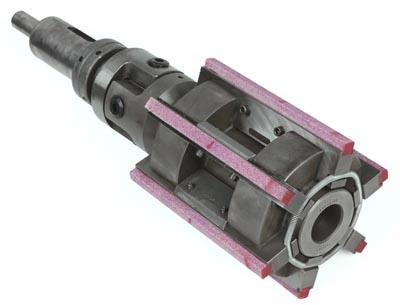
Sunnen Products Co. is introducing a 60-grit premium red aluminum-oxide honing abrasive that reportedly cuts material 25 to 50 percent faster than other conventional stones, depending on the workpiece material. The new abrasive formulation resists chip loading and galling even in stainless steel. It is available for all current Sunnen General Hone tools, as well as those of other manufacturers.
The 60-grit abrasive is specifically formulated for machining oil/gas industry parts where fast, base-metal removal is critical to enlarging a bore in a short cycle time. According to Sunnen, the 60-grit aluminum oxide abrasive is an ideal alternative for shops where inexperienced machine operators might damage a set of faster-cutting, but higher cost superabrasives, or where inferior honing oils may be in use.
"This is a good compromise for shops that want fast metal removal without the risk of wrecking superabrasive stones, which are really the optimal solution," says Dennis Westhoff, Sunnen Business Development Manager. "We developed this product for those shops that prefer to trade a somewhat longer cycle time and shorter stone life for much lower initial cost and risk."
In field tests, the red abrasive significantly outperformed brown aluminum-oxide, and remained clean while cutting stainless steel at high horsepower.
Contact Details
Related Glossary Terms
- abrasive
abrasive
Substance used for grinding, honing, lapping, superfinishing and polishing. Examples include garnet, emery, corundum, silicon carbide, cubic boron nitride and diamond in various grit sizes.
- aluminum oxide
aluminum oxide
Aluminum oxide, also known as corundum, is used in grinding wheels. The chemical formula is Al2O3. Aluminum oxide is the base for ceramics, which are used in cutting tools for high-speed machining with light chip removal. Aluminum oxide is widely used as coating material applied to carbide substrates by chemical vapor deposition. Coated carbide inserts with Al2O3 layers withstand high cutting speeds, as well as abrasive and crater wear.
- galling
galling
Condition whereby excessive friction between high spots results in localized welding with subsequent spalling and further roughening of the rubbing surface(s) of one or both of two mating parts.

